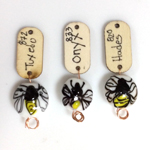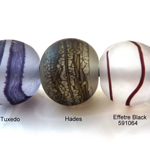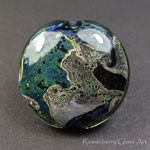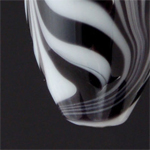CiM Tester Feedback
-
How does Tuxedo compare to other 104 blacks? Testers reported that they prefer Tuxedo because it is denser / blacker.
"Effetre turns purple but continues to have crisp lines, while Tuxedo stays black, but fuzzes out around the edges. I'll take the fuzzy lines over the purple tint.” – Bethany Lemasters
"The third Black on the market is provided by CiM-Messy Color and it is a dark Gray-Black that stays very dense when pulled down to a stringer, making Tuxedo a great contender for best Black on the world market." Read more at the Frantz Art Glass blog. – Patricia Frantz
“I like this very neutral black. The Italian glasses tend to be either on the purple side, or green side. Tuxedo's meltability is FAR better than the Italian black, and it is a bit denser. Effetre black [and Vetro] are horrendous. They boil and pit so bad, but at least the Effetre black smooths out. My only problem with Tuxedo is that I couldn't get it to etch properly at all. Tuxedo didn't completely etch smooth matte, it was more of a satin etch. With that said, if I’m not etching, I would prefer Tuxedo over the Italian blacks any day.” – Renee Wiggins
“Vetrofond black is denser than Tuxedo. Effetre black is not. With solid work, Tuxedo functions very well. For stringers and dots, the Italian blacks are much better.” – Angela Hadorn
“Tuxedo is a true black, not a purple black, and doesn’t ‘act up’ as the Italian blacks do lately.” – Elasia
“I always use Effetre black. I’ve found that Tuxedo is denser than other 104 blacks but it has an odd effect on some stringer. Example – Effetre White on Tuxedo goes all wobbly and slightly feathery.” – Laura Sparling
“I find Tuxedo melts more smoothly and is easier to use, so I use this as my go to black.” – Gail Witt
“The other blacks are purple, blue, or whatever. Tuxedo is actually black. At the very worst, if it is applied too thinly or allowed to spread out too much, it looks grey.” – Kathy Coon
“Tuxedo is a very close second as my favorite black glass to work with – Hades being my favorite. It does not boil or pit, is a good consistency for sculpting, and while it will web if exposed to enough heat, it does not do so easily enough to pose a big problem.” – Carol Oliver
“Tuxedo does not 'purple' out on me like Effetre black. I use Tuxedo for surface decoration only. It overruns other colors and I don’t like the look when compared to the Italian glasses, especially Vetrofond black. It is like Tuxedo is a flatter black than the Italian glasses.” – Chris Haussler
“Tuxedo is my staple black, because of the price difference from Hades. Tuxedo is a superb value and it’s a fantastic black to work with.” – Donna Dorman
“Tuxedo might be blacker than regular Italian blacks. It is something between them and intense blacks, colour and behavior.” – Maija-Leena Autio
"Tuxedo is a great black, it stays black in thin stringer." – Caroline Davis
-
What is the difference between Hades & Tuxedo? Hades is our intense black (will maintain its black color even when pulled into stringer) and Tuxedo is our regular black (less dense).
“For me, Hades is a 'true' black and Tuxedo is a very deep grey. Both will get a bit squirrelly with enough heat.” – Chris Haussler
“If you melt Hades into white the resulting line will appear black. If you do the same test with Tuxedo, the line appears more purple.” – Gail Witt
“Both Hades & Tuxedo are ‘proper’ black instead of really dark purple or blue or whatever; I choose between the two based on how reactive they are with other colors. Tuxedo is rich and stable when I’m not looking for reactions, spreading, or webbing.” – Kathy Coon
“To me, Hades is a richer, jet black, while Tuxedo looks the same in a solid bead, but when used as decoration like dots or stringer work, it can look a little less saturated black.” – Lori Bergmann
“Tuxedo appears to have a purple base, while Hades looks more blue based. Hades is more dense.” – Teri Yount
-
Technically speaking, Tuxedo is a blue based black, but testers disagreed on their experience of Tuxedo's hue cast.
"Tuxedo is a standard black color, which is a dense transparent like the other black glass versions from Vetrofond and Effetre. But it differs from them in that while Vetrofond has a bluish cast and Effetre has a purple cast when they bleed around the edges, Tuxedo has a grayish-brown cast." Read more at Lori's blog. – Lori Bergmann
"While it looked pure black and grey and white when it went into the kiln - it has stretched and thinned out to both purple and blue, interestingly enough." Read more at DragonJools blog. – Dwyn Tomlinson
“A very, very, very dark grey.” – Chris Haussler
“Blue/purple.” – Gail Witt
“A deep, dark green.” – Kirsty Naray
"Blue-gray." – Angela Hadorn
"Deep purple/blue." – Carol Oliver
“Grey/dark green." – Elasia
“Navy blue.” – Pat O'Brien
-
We asked our testers to compare Tuxedo & other 104 blacks in their ease to bleed. Testers reported wildly different experiences.
"I discovered that Tuxedo also has a tendency to bleed much more easily than it's big brother Hades, which is my favorite black that is a more dense and blacker formula and has wonderful reactions with silver colors." Read more at Lori's blog. – Lori Bergmann
"It also does seem to have webbed a little bit." – Dwyn Tomlinson
“I like that Tuxedo is a cheaper alternative to Hades, but noticed that it tends to bleed and/or frazzle fairly quickly. And I don’t like it much for stringer work because it gets a brownish tinge around the edges when melted in. When I used it on a twisty combination, it also looked brown instead of black. So I think I’ll be using it just for solid black shapes or as a base layer and using Hades for any stringer or twisty designs. It does seem like it has some nice organic possibilities, as I got a neat reaction with it over Stone Ground.” – Lori Bergmann
“Tuxedo is not very popular. It bleeds a lot faster than the Italian black.” – Angela Hadorn
“Tuxedo doesn’t bleed or web." – Elasia
“Tuxedo does web with intense heat, but I think it is much less bleed-y than effetre black.” – Gail Witt
“Tuxedo is much more likely to stay where you put it. I think that it bleeds much less than the Italian blacks.” – Kathy Coon
"Tuxedo is more bleedy." – Kirsty Naray
“Tuxedo bleeds more and that´s why I do not like it. Intense blacks can bleed, if they want to, but I like my regular black to be stable. But I have found out there are lot of people, who like it and think it is not bleeding." – Maija-Leena Autio
“Tuxedo will web/bleed when exposed to intense heat, but not as much as Hades or Effetre Intense black.” – Carol Oliver
“In some applications, Tuxedo does web and bleed on me. It is more prone to bleed than the Italian blacks. I have issues using it next to clear, as it tends to creep over the clear and mess up the line that I am trying to lay down. I use it next to other colors intentionally. When it bleeds then, it is not an issue because it adds an interesting effect to the finished product. If I need to have black next to clear and I am expecting it to behave, I use Vetrofond black or Hades.” – Chris Haussler
“Tuxedo webs just as much as Hades does equally as much.” – Pat O'Brien
-
Special thanks to Genea Crivello-Knable (x2), Leslie Anne Bitgood (x2), Bethany Lemasters, Pat O'Brien, Carol Oliver, & Sue Stewart for providing the photos in this section.
"I tested Onyx, Tuxedo, and Hades to see which one holds the black the best. I like Tuxedo the best for stringer use. It holds the line pretty well."
– Suzanne Cancilla-Fox
|

|

| "I used Tuxedo here. It's dense and stiff to work with. Still has some bubbling but remains my go to black."
–
Tammy Mercier
|
"Tuxedo is my go to for black."
– Suzy Hannabuss
|

|

| "Tuxedo rolled in Double Helix Triton frit. Spiralled with Effetre transparent Pale Aquamarine 038 and then encased with it." See more eye candy at Laura's tumblr. |
"For encased twistie with fine black stripes head for Tuxedo [far right bead] as on balance it is the least expensive and most readily available of the three CiM glasses tested." Read more at Kitzbitz Art Glass' blog. |

|

| “In the photo you can see that I used SIS on a base of Tuxedo black. You will notice the pretty webbing, but if you look at the edges of the band of SIS you will see that it doesn't spread!” Read more on Genea’s blog on Art Jewelry Elements. |
“On a base of Tuxedo, 99% fine silver foil was added and layered with Val Cox Wild Raspberry frit, a fine mix of pinks. The combination was then melted into the surface. The result is a golden peachy-rose brown silvered pattern on each bead.” See more at Darlene’s blog. |

|

| Silvered Tuxedo shards reduced over Stone Ground.
–
Carol Oliver
|
"Hades and Tuxedo are very different colors. Hades has more of a green/black base while Tuxedo is a 'super blue' glass. Both sets of shards are silvered [rolled in fine silver foil before blowing] but that does not appear to have affected the base color. Interestingly, both still appear black on the glass when laid down in shard form but the shards of Tuxedo appear to reduce to a denser blue than the shards of Hades."
– Carol Oliver
|

|

| “But the biggest surprise result in this test is the colour of the different blacks - I expected the Effetre black to appear quite purple when etched, but look at that Tuxedo – it’s indigo!” Read more at Lush Blogs. |
"The small disc beads in the pic have been fumed with fine silver in a fairly propane rich reduction flame - nothing happened until I turned the oxygen right down. I found that the results are a little flat, dull and inconstant for me after seeing the beautiful shimmers, silver droplets and hints of iridescence that I have been able to achieve with the silvered Tuxedo stringer. The large oval bead in this picture is a Tuxedo base, with silvered Tuxedo stringer, wafted quickly through a reduction flame." Read more at Craft Pimp. |

|

| “Double Helix Psyche shards were applied to Tuxedo. Like magic, this silver infused glass that is normally purple, turned shades of metallic blues and greens! . . . Droplets of CiM's Gunmetal were added."
–
Darlene Collette
|
"I did a bead that was a base of Tuxedo and wrapped in silver foil, added some silvered ivory shards, reduced, then encased in Lauscha. The colours in the base are just the Tuxedo reacting with the silver!"
– Claire Morris
|

|

| "These are dots of Reichenbach Magic on black CiM Tuxedo super heated, and mashed. Nice range of colours, and the speckly web pattern in the middle of the dots is interesting too." Read more at DragonJools blog. |
"You can see how much the Tuxedo bled and reacted over the base color, which made me think of an animal print pattern. I was surprised by the brownish bleeding effect and it made me immediately think of fur. I thought it might make some great Tiger skin beads, so I combined it with Peace white to make twisties, then layered them between transparent Amber to get these." Read more at Lori's blog. |

|

| "Here is a leopard print heart using Messy Tuxedo and Effetre light & dark topaz. Where the black lines are heated and cooled with a bit more concentrated heat, the black spreads a bit giving it a more soft line. This softness of the black lines gives a more natural animal print look rather than sharp black lines."
–
Genea Crivello
|
"Red end then Hades, Tuxedo and Gunmetal on the bottom. Each spider differently. Stringers were approximately the same diameter. Hades has a more green/brown edge, Tuxedo has a more blue/violet edge and Gunmetal a much warmer brown sometimes violet edge and spiders with the most variation in color."
– Leslie Anne Bitgood
|

|

| "Tuxedo is great for all the situations where you would use a regular black, it resists bleeding and is priced to be competitive with the blacks made in Italy. Tuxedo is a very nice black glass to work with because I find that it rarely if ever pops when heated directly in the flame, like the blacks produced in Italy." Read more at the Frantz Art Glass blog. |